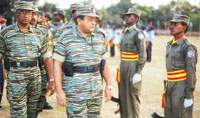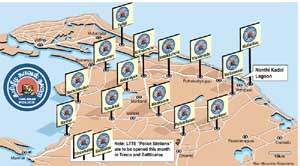 I- Inside
Wanni
I- Inside
Wanni |
|||||||
|
Situation Report ll - Expanding Tiger civil service Tiger police force: problem for peace Tiger guerrillas in civ vies, clasping Ameri can M16 or Russian Kalashnikov AK47 assault rifles, form a human wall ahead of iron barricades across the road. Others speak into walkie-talkies, presumably updating a "command center" of what was going on.
Activity is
hectic at this strategic junction, once the gateway to the Security
Forces complex at Mullaitivu, and now a major Tiger guerrilla base.
Boards in red and white say "NIL" in Tamil or STOP in
English. They are placed in the middle of the road. After six years of "Eelam War Three," seizing the six-month old truce between the Government and the LTTE, mammoth crowds are heading towards the Vattapalai Amman Kovil, a most venerated place of Hindu worship. It was the annual Pongal festival. The Kovil is located in the middle of a vast expanse of open land. There are no trees to cover the view for several kilometers. The long winding motorcade looks like a giant train in motion.
I ask Daya Master, who was escorting us, whether we could drive up to see the former Security Forces complex in Mullaitivu, speak to fishermen on the beach and later visit the Kovil. He agrees. As I arrive near the barricade in our Double Cab, a guerrilla aims his M-16 rifle at me. He orders me to stop. I brake and switch off the engine. Daya Master walks up to a cadre and explains. I see him speak into a walkie-talkie. Within seconds, he waves his hands and says in English "carry on!" The armed men pull two barricades to allow us entry. Once we were in, they are replaced.What was once the Security Forces complex, with a Naval Sub Unit, is no more. The blasted rubble from buildings, twisted wreckage of vehicles, pock-marked walls that have survived many a gun battle and charred trees still bear testimony to the guerrilla attack on the Mullaitivu Security Forces complex at 1.30 a.m. on July 18, 1996 - one of the worst in the 19-year-long separatist war. There were 1,407 men there, mostly Army and small contingents of Navy, Police and civilians. More than 1,200 were killed in this attack, which came just ten months after the previous Government directed a series of military thrusts codenamed "Operation Riviresa," to re-capture Jaffna peninsula. Under a tight censorship, the then Government denied for many weeks that the Security Forces complex in Mullaitivu had fallen into LTTE hands. It was argued the guerrillas, who had made a retreat to the Wanni after the fall of Jaffna, were too weak and disorganized. They were on the run, itwas claimed. As the news blackout eased, the reality emerged. Far from being emaciated, they had crossed the threshold, from being a deadly guerrilla outfit to one capable of assuming the role of a conventional force when necessary. They had avoided occupying the ground used as the Security Forces complex. Instead, their base lay in close proximity. As we move on the road along the shore, Cameraman Alfred Silva and I see two green coloured Tata Benz trucks. They stillbear Army registration numbers. They were among vehicles captured. Ahead of us, a distance away along the coastline, we could see "Iris Moana" and "Missen" - the two vessels seized by Sea Tigers. However, we see no fishermen. They had set out to sea and not returnedthough it was near dusk by then. We return to the guerrilla roadblock. Barricades are removed. We move into a gap in the unending stream of traffic heading towards the farming village of Vattapalai. We could only keep to speeds of 10 or 20 kilometres per hour. We drive skirting around the Nanthi Kadal Lagoon. As dusk envelopes the area, the bright lights around the Vattapalai Amman Kovil are visible for many kilometers. It resembles an international airport at night.As we arrive at the entrance to the Kovil, we are greeted by uniformed men and women of "Tamil Eelam Police." They direct us to a parking lot, dried up paddy land the size of at least four football fields. More policemen there are directing cars, lorries, buses, vans, coaches, pick up trucks and tractors to parking lots. A parking fee of Rs 50 has to be paid for before entry. A policeman
whom I speak to says over 625 vehicles are already parked. More
are coming in rows. In another parking area, thousands of bicycles
lay row after row. It had reached 40,000 mark when I saw it. Further
away lay lots for motorcycles, acommon mode of transport. Unlike
in the South, they always carry more than three persons. Some 8,000
were there and more were coming in by the minute. An announcement over the public address system appeals to the police to move into section "A" where there was some commotion. It turns out that devotees were competing with each other for ground space and a fracas had ensued. There are no complaints of thefts, sexual harassment or violence.An occasion with such large crowds is always a nightmare even for the Sri Lanka Police. Top brass planning security has to take into consideration traffic arrangements, criminal activity, thefts and the safety of those coming in. Emergency medical care has to be planned for. Strength would have to be drawn in from other Police Stations. The security of visiting VIPs had to be catered to. This is where the LTTE seems to have made a significant impact. Withdrawing from the Jaffna peninsula in the wake of "Operation Riviresa," and during the six years of holding the Wanni area, they had embarked on elaborate programmes to expand their civilian support base. One such measure has been the creation of a "Tamil Eelam Police." Though established whilst the LTTE was dominating the Jaffna peninsula, it was only in the Wanni that it has taken firm roots. "We have now been in existence for the past ten years. There are 14 Police Stations in the Wanni. (See map on this page) We will soon open two Police Stations in the East," says the "Inspector General of Police of Tamil Eelam," Balasingham Mahendran who is better known by the LTTE nom de guerre Nadesan. Cameraman Alfred Silva and I visited nine of these Police Stations at Kilinochchi, Mullaitivu (Puthukudiyiruppu), Viswamadu, Pallai, Mankulam, Akkarayan, Thunnukai and Puliyankulam. They are much the same as Police Stations in the South. There are name boards outside. Inside, uniformed men and women are on duty. The stations are linked by radio to a "Police Headquarters" in Kilinochchi. There is a Reserve or Reception table and a cell. However, instead of a photograph of President Chandrika Bandaranaike Kumaratunga, a portrait of LTTE leader, Velupillai Prabhakaran, hangs in a prominent place in the wall. Police stations are also located at Mulliyawalai, Vattakachchi, Nachikudah, Mannar, Jeyapuram and Nedunkerni. Police posts are also located in rural areas. "Police Chief" Nadesan, who once served in the Sri Lanka Police, (see interview on this page) says new police stations will soon be open in (LTTE held areas) in Trincomalee and Batticaloa. "Our people have already gone there to make the necessary arrangements," he adds. According to Mr. Nadesan, the "Tamil Eelam Police" act on what he calls the "Kutta Viyal Nadavadikkai" or the LTTE's own Criminal Procedure Code. He says the police investigate public complaints and file indictments in the "Tamil Eelam Magistrate's Courts." If convicted, the accused are sent to "Rehabilitation Centres" and not to jails. For a month, he says, there are convictions in over fifty cases. The Sunday Times learnt that in addition to being posted to "Rehabilitation Centres" those found guilty of "serious offences" were being sent to "hard labour" terms in farms run by the LTTE. I asked Mr. Nadesan what the role of "Tamil Eelam Police" would be if and when the Government concedes the LTTE an Interim Administration. His reply "definitely we will maintain law and order in our areas." He says plans are afoot to further expand the service by opening up more police stations. A police academy is recruiting and training youth for the police service. There is also a law college from where lawyers are passing out, he points out. An Interim Administration for the LTTE in the North and East, a subject for discussion at upcoming peace talks in Thailand, will no doubt be a knotty issue for the Government. If the enforcement of law and order is through the "Tamil Eelam Police," there will be no role for the Sri Lanka Police in the North and East. Hence they would not be able to enforce the laws of the land there. On the other hand, if the Government is to insist that law and order functions, like in other areas, should be the prerogative of the Sri Lanka Police, it is impossible to assume the LTTE would disband their Police service. It has established itself considerably in the six years in Wanni. The "Tamil Eelam Police" and the maintenance of law and order in LTTE dominated areas under an Interim Administration, is just one of the many major issues that would have to be resolved when Government-LTTE talks begin in Thailand. There are serious doubts whether the talks could get off the ground this month. The battles for those waging peace have just begun. They would have to resolve them before the two sides could sit down to talk on core issues, that elusive major hurdle, before peace could dawn. If not more, that seems as increasingly difficult as waging war. |
|||||||
|
Situation Report Archives
Copyright © 2001 Wijeya Newspapers
Ltd. All rights reserved. |
|||||||

